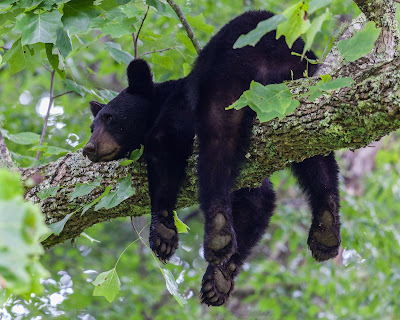Black bears have short, non-retractable claws that give them an excellent tree-climbing ability.
Black bear fur is usually a uniform color except for a brown muzzle and light markings that sometimes appear on their chests. Eastern populations are usually black in color while western populations often show brown, cinnamon, and blond coloration in addition to black. Black bears with white-bluish fur are known as Kermode (glacier) bears and these unique color phases are only found in coastal British Columbia, Canada.
Black Bear (click here)
Height: About 3 feet at the shoulder and 5–7 feet tall when standing upright
Weight: Ranges from 100 to 600 pounds depending on age, sex, and season
Average Life Span: 15–25 years
Did You Know? Despite their name, black bears can be black, cinnamon, blonde, blue/gray, or even white!
While bears of the same species might look similar, everything from their size, coloring, diet, and sleeping patterns depend on the bear and its location. For example, a bear’s diet varies depending on what foods are available during a specific season in a specific region. The home range for an adult black bear can vary depending on the location, season, and food availability.
Let’s take a look at two different black bears, one in Great Smoky Mountains National Park and another in Glacier Bay National Park and Preserve to see how they differ in diet, winter denning, and life cycle. For more information about bears and bear behavior in a specific national park, please contact that park.
Black bears will eat almost anything. They are omnivores, meaning that they eat both plants and animals. Their curved claws help them climb trees to search for food, but they cannot dig for food as well as a brown bear. Black bears are very smart and can identify food not only by smell but also by appearance. Bears who have been fed human food will begin to associate campsites, bags, garbage cans, and even cars with food. These food-conditioned bears can become dangerous. So please remember: Don’t let bears get your food or garbage! Help keep them wild by following these tips on food storage and bear safety.
Storing Food
Bears learn quickly and will return to areas where they find food. Not only can this be dangerous for people, but it is also harmful to bears....
Kindly be sensitive to habitat. Healthy bear habitat will serve them well and they won't be tempted to wander into places where people live. Once they experience a human food source it may be necessary to capture the bear and return it to the wild at a distance.
Please understand when it comes to wildlife there is no eliminating them completely. There will always be wild animals that travel the North American continent.
Bears, like most wildlife, didn't draw the gerrymandered congressional district that one lives in, so don't expect them to understand boundaries. The wildlife rangers or officers know what to do with wayward bears and will provide any advise and/or intervention if needed.
Bears are wonderful to watch at a distance. The Black Bears usually are calmer then the Brown Bear. The White Bears that are only white in color are black bears. They are called "Spirit Bears" in western Canada.
